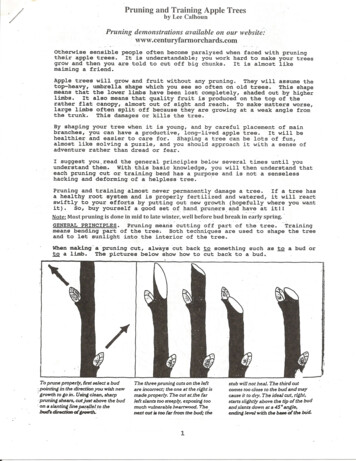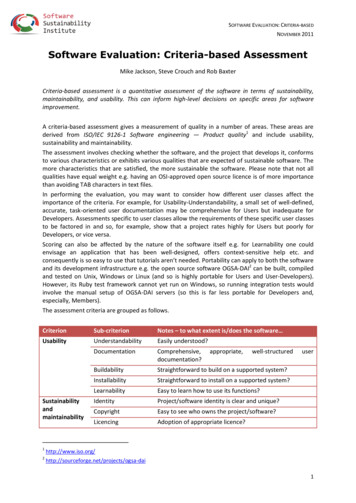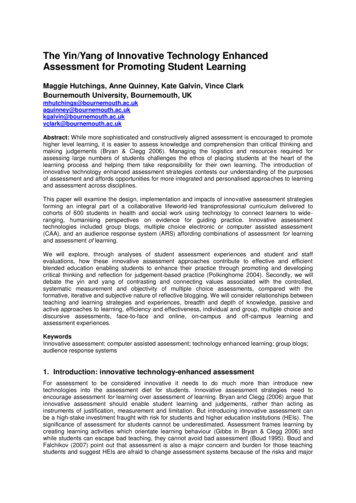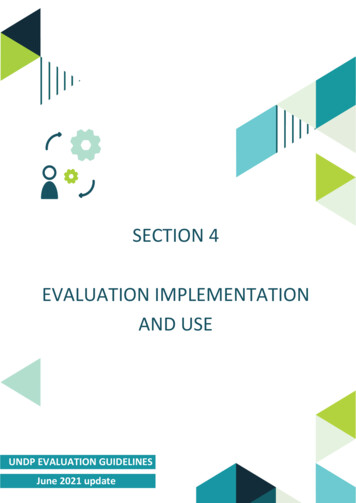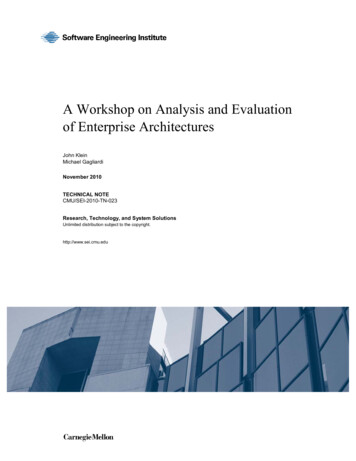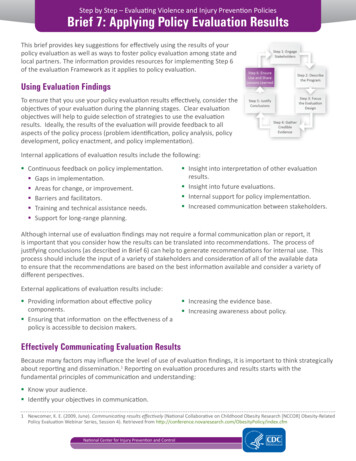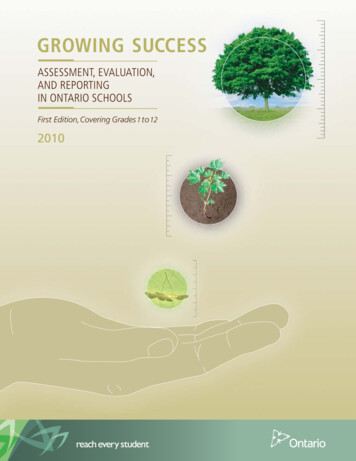
Transcription
CONTENTSCONTENTSIntroduction11. Fundamental Principles52. Learning Skills and Work Habits in Grades 1 to 1293. Performance Standards – The Achievement Chart154. Assessment for Learning and as Learning275. Evaluation376. Reporting Student Achievement477. Students With Special Education Needs: Modifications, Accommodations,and Alternative Programs698. English Language Learners: Modifications and Accommodations759. E-Learning7910. Credit Recovery83Appendix 1: Large-Scale Assessments91Appendix 2: Progress Report Card and Provincial Report Card Templates97Appendix 3: Resources for Particular Policy and Program Areas139Glossary143References157Une publication équivalente est disponible en français sous le titresuivant : Faire croître le succès : Évaluation et communication du rendement des élèvesfréquentant les écoles de l’Ontario. Première édition, 1 re – 12 e année. 2010.This publication is available on the Ministry of Education’swebsite, at http://www.edu.gov.on.ca.
1INTRODUCTIONThis document supersedes the sections outlining assessment, evaluation, and reporting policyin The Ontario Curriculum, Grades 9 to 12: Program Planning and Assessment, 2000 and incurriculum policy documents for Grades 1 to 8, Grades 9 and 10, and Grades 11 and 12 publishedbefore the release of this document, with the following exception: The achievement charts in allcurrent curriculum policy documents remain in effect. This document also supersedes the followingdocuments and memoranda: Guide to the Provincial Report Card, Grades 1–8, 1998 (as updated on the ministry websiteon September 5, 2000) Guide to the Provincial Report Card, Grades 9–12, 1999 Deputy Minister’s Memorandum dated September 5, 2000: “Changes in Reporting the Strandsof Mathematics on the Elementary Report Card”INTRODUCTION Directors’ Memorandum, Curriculum and Assessment Policy Branch and French LanguageEducation Policy and Program Branch, dated May 24, 2006: “Revision to Provincial Report Card,Grades 9–12: The Expansion of Eligible Courses Recognized as Compulsory for the OSSD” Acting Director’s Memorandum, Curriculum and Assessment Policy Branch, dated June 22, 2006:“Release of Revised Grades 1–8, Language, 2006, Curriculum Policy Document”Beginning in September 2010, assessment, evaluation, and reporting in Ontario schools will bebased on the policies and practices described in this document.The present edition of this document includes all relevant and final informationpertaining to Grades 1 to 12. A forthcoming edition, planned for release in 2011,will complete the document, including information pertaining to the curriculumfor the new full-day Kindergarten program (planned for release in 2011).The Ontario government is committed to enabling all students to reach their potential, and to succeed.Our challenge is that every student is unique and each must have opportunities to achieve successaccording to his or her own interests, abilities, and goals. We have defined high expectations andstandards for graduation, while introducing a range of options that allow students to learn in waysthat suit them best and enable them to earn their diplomas. We are proud that our students regularlyplace among the world’s best on international standardized tests.
2G R OW I N G S U C C E S S assessment, evaluation, and reporting in Ontario schoolsThe Ministry of Education’s assessment, evaluation, and reporting policy has evolved significantly overthe course of the last decade. Previously, aspects of the policy appeared in a number of documentsand were not fully aligned across the elementary and secondary panels. In addition, stakeholdersoften expressed concerns about unevenness in the way the policies were being implemented amongboards and schools. The present document updates, clarifies, coordinates, and consolidates the variousaspects of the policy, with the aim of maintaining high standards, improving student learning, andbenefiting students, parents,1 and teachers in elementary and secondary schools across the province.The document is intended to ensure that policy is clear, consistent, and well aligned across panelsand across school boards and schools, and that every student in the system benefits from the samehigh-quality process for assessing, evaluating, and reporting achievement.INTRODUCTIONThis document, in its forthcoming final edition, will outline a comprehensive policy for the assessment,evaluation, and reporting of student achievement in Ontario schools, from Kindergarten to Grade 12.The policy is based on seven fundamental principles, the first of which tells us that assessment,evaluation, and reporting practices and procedures must be fair, transparent, and equitable forall students. At the same time, students and parents need to know that evaluations are based onevidence of student learning and that there is consistency in the way grades are assigned acrossschools and boards throughout the province. With this knowledge, students can have confidence in theinformation they use to make decisions about secondary pathways and postsecondary opportunities.The policy outlined in this document is designed to move us closer to fairness, transparency, andequity, as well as consistent practice.Successful implementation of policy depends on the professional judgement of educators at all levels,as well as on educators’ ability to work together and to build trust and confidence among parentsand students. It depends on the continuing efforts of strong and energized professional learningcommunities to clarify and share their understanding of policy and to develop and share effectiveimplementation practices. It depends on creative and judicious differentiation in instruction andassessment to meet the needs of all students, and on strong and committed leadership from schooland system leaders, who coordinate, support, and guide the work of teachers.Recognizing that the needs and circumstances of individual boards vary widely, the policy outlinedin this document provides flexibility for boards to develop some locally focused guidelines andimplementation strategies within the parameters for consistency set by the ministry. Educationstakeholders throughout the province have voiced the need for greater consistency in assessment,evaluation, and reporting practices among the schools within a board, and initiatives to achieveimprovement in that regard are strongly encouraged. Board guidelines should always be developedin collaboration with all the schools in the board, and in consultation with the school community.1. Throughout this document, parents is used to refer to both parents and guardians.
INTRODUCTIONPolicies and procedures for assessment, evaluation, and reporting need to develop over time, as welearn more about how students learn. The policies outlined in this document reflect the current stateof our evolving knowledge about the learning experience. New approaches to assessment provideboth opportunities and challenges to all educators, for the benefit of all students.The Organization of This DocumentThe first chapter of this document lays out the fundamental principles that form the foundation ofall policy outlined in the remaining chapters. Chapter 2 focuses on learning skills and work habits.It comes immediately after the discussion of fundamental principles to reflect the importance ofthese skills and habits, in the view of all education stakeholders in Ontario, for the education andsuccess of our students. Chapter 3 presents policies related to performance standards, as representedin the Achievement Chart and described in current Ontario curriculum policy documents.Chapter 4 represents new understandings and policy related to the role that assessment can play inthe improvement of student learning, and clarifies the differences between assessment for learning,INTRODUCTIONassessment as learning, and assessment of learning (or evaluation).Chapters 5 through 8 update, clarify, consolidate, and coordinate policies for evaluating andreporting student achievement. These chapters address key issues such as gathering evidence ofstudent learning; dealing with late and missed assignments; and using the code “R” and percentagemarks below 50 per cent, as well as the code “I”, in the evaluation and reporting of studentachievement. They also present guidelines for school boards to develop some of their own policiespertaining to issues such as late and missed assignments and plagiarism, explain the use of thenew fall Elementary Progress Report Cards, and discuss policies pertaining to students with specialeducation needs and students who are learning English.The remaining two chapters present policies related to assessing, evaluating, and reporting studentachievement as they pertain to e-learning and credit recovery.Each of the ten chapters in this document is organized in two parts. The first part outlines thepolicy, and the second part discusses the context for the policy or additional considerations relatedto the policy. It is anticipated that the context sections will provide educators with a deeperappreciation of the policies – of their intent, the theories of current educational experts that informthem, and the ways in which they will benefit student learning – and that they may serve tosupport professional learning.3
4G R OW I N G S U C C E S S assessment, evaluation, and reporting in Ontario schoolsThree appendices, a glossary, and a list of references are included at the end of the document.Appendix 2 contains templates for the elementary progress report cards and the elementary andsecondary provincial report cards. Appendices 1 and 3 provide information about large-scaleassessments administered in Ontario and about resources for particular program and policyareas, respectively.Assessment, Evaluation, and Reporting in Particular Policyand Program AreasINTRODUCTIONThe principles and policies outlined in this document apply to assessment, evaluation, and reportingpractices in all programs, including Specialist High Skills Major programs, cooperative education, anddual credit programs, and in specific policy areas, such as prior learning assessment and recognition(PLAR) and the secondary school literacy graduation requirement. This document does not, however,provide information about procedures and practices specific to these areas that is already availablein dedicated resources. See Appendix 3 for an inventory of such resources. (The list includes resourcesthat boards require to administer the Adjudication Process for students who are eligible to meettheir literacy graduation requirement through adjudication.)
1G R OW I N G S U C C E S S assessment, evaluation, and reporting in Ontario schoolsFUNDAMENTAL PRINCIPLES
6FUNDAMENTAL PRINCIPLESP O LI C YThe primary purpose of assessment and evaluation is to improve student learning.The following seven fundamental principles lay the foundation for rich and challenging practice.When these principles are fully understood and observed by all teachers, they will guide the collectionof meaningful information that will help inform instructional decisions, promote student engagement,and improve student learning.The Seven Fundamental PrinciplesFUNDAMENTAL PRINCIPLESTo ensure that assessment, evaluation, and reporting are valid and reliable, and that they leadto the improvement of learning for all students, teachers use practices and procedures that: are fair, transparent, and equitable for all students; support all students, including those with special education needs, those who are learning thelanguage of instruction (English or French), and those who are First Nation, Métis, or Inuit; are carefully planned to relate to the curriculum expectations and learning goals and, as muchas possible, to the interests, learning styles and preferences, needs, and experiences of all students; are communicated clearly to students and parents at the beginning of the school year or courseand at other appropriate points throughout the school year or course; are ongoing, varied in nature, and administered over a period of time to provide multipleopportunities for students to demonstrate the full range of their learning; provide ongoing descriptive feedback that is clear, specific, meaningful, and timely to supportimproved learning and achievement; develop students’ self-assessment skills to enable them to assess their own learning, set specificgoals, and plan next steps for their learning.
C H A P T E R 1 fundamental principles7CONTE XTThese fundamental principles, which are based on the Principles for Fair Student Assessment Practicesfor Education in Canada, developed by the Joint Advisory Committee, Centre for Research in AppliedMeasurement and Evaluation, at the University of Alberta, are central to all assessment, evaluation,and reporting policies and practices. These include policies and practices applied in connectionwith the achievement of curriculum expectations and the demonstration of learning skills andwork habits. The policies outlined in this document are designed to reflect and/or build on thesefundamental principles.FUNDAMENTAL PRINCIPLESFor example, transparency is achieved when student learning is assessed and evaluated accordingto the clear standards outlined in the curriculum expectations (the content standards) provided inall curriculum documents for Grades 1 to 12, and according to the four categories of knowledgeand skills and the four levels of achievement (the performance standards) outlined in the achievementchart that appears in every curriculum document.Education directly influences students’ life chances – and life outcomes. Today’sglobal, knowledge-based economy makes the ongoing work in our schools criticalto our students’ success in life and to Ontario’s economic future. As an agentof change and social cohesion, our education system supports and reflects thedemocratic values of fairness, equity, and respect for all. The schools we createtoday will shape the society that we and our children share tomorrow.(Ontario Ministry of Education, 2009, p. 6)In keeping with the principle of supporting all students, policy and the implementation of policymust respond to the needs of a variety of students. As the Ontario Expert Panel on Literacy andNumeracy Instruction for Students With Special Education Needs has noted in its report Educationfor All (2005), “Treating all children exactly the same means that children who need accommodationsor modifications to the program in order to succeed will be disadvantaged. Some students requiremore or different support than others in order to work at a level appropriate to their abilities andneeds” (p. 5). For some students, therefore, assessment, evaluation, and reporting will be based onmodified expectations. For a few other students, where the expectations in the Ontario curriculumdo not form the basis of all or part of their program, assessment, evaluation, and reporting may bebased on alternative expectations. In addition, accommodations must be provided for many studentswith special education needs, as well as for many English language learners who are beginning toacquire English as a new language. The ministry, school boards, and schools are also responsiblefor ensuring effective and appropriate instructional and assessment practices that meet the uniqueneeds of First Nation, Métis, and Inuit students.1
8G R OW I N G S U C C E S S assessment, evaluation, and reporting in Ontario schoolsFairness in assessment and evaluation is grounded in the belief that all studentsshould be able to demonstrate their learning regardless of their socio-economicstatus, ethnicity, gender, geographic location, learning style, and/or need forspecial services.(Volante, p. 34)Inclusive education is central to the achievement of high-quality education forall learners and the development of more inclusive societies. Inclusion is stillthought of in some countries as an approach to serving children with disabilitieswithin general educational settings. Internationally, however, it is increasinglyseen more broadly as a reform that supports and welcomes diversity amongstall learners.FUNDAMENTAL PRINCIPLES(UNESCO, p. 5)We know that parents have an important role to play in supporting student learning. Studies showthat students perform better in school if their parents or guardians are involved in their education.This is the basis for the principle that students and parents should be kept fully informed about thestudent’s progress. It is essential that schools have procedures in place to ensure that parents areaware of the expectations for their child in the various grades. Principals play a key role in developingthese procedures, which should be designed to create the conditions for student success by ensuringthat parents have the information they need to interpret their child’s report card and to work withteachers to improve their child’s learning.Teachers have a leading role to play in the implementation of the seven fundamental principles. On adaily and hourly basis, teachers make professional judgements that ensure effective implementationof these principles, making decisions with respect to individual students and groups of students thathave profound implications for them. How students feel about themselves as learners and whetherthey enjoy learning and strive for excellence are closely related to their teachers’ professional skillsboth in differentiating instruction and assessment and in helping students understand how theycan improve. Teachers create environments in which all students feel valued and confident and havethe courage to take risks and make mistakes. In their important professional role, teachers showstudents that they care about them, and model a love of learning that can deeply influence theirlives. Teachers’ professional judgements are at the heart of effective assessment, evaluation, andreporting of student achievement.
2G R OW I N G S U C C E S S assessment, evaluation, and reporting in Ontario schoolsLEARNING SKILLS AND WORK HABITS IN GRADES 1 TO 12
10LEARNING SKILLS AND WORK HABITS IN GRADES 1 TO 12LEARNING SKILLS AND WORK HABITS IN GRADES 1 TO 12P O LI C YThe development of learning skills and work habits is an integral part of a student’s learning. To theextent possible, however, the evaluation of learning skills and work habits, apart from any that maybe included as part of a curriculum expectation in a subject or course, should not be considered inthe determination of a student’s grades. Assessing, evaluating, and reporting on the achievementof curriculum expectations and on the demonstration of learning skills and work habits separatelyallows teachers to provide information to the parents and student that is specific to each of thetwo areas of achievement.An example of when it is not possible to separate the evaluation of the learning skills and workhabits from the evaluation of a student’s achievement of a curriculum expectation may be foundin the health and physical education curriculum. That curriculum includes Living Skills expectations,which students are expected to achieve in the context of their learning in the Active Living, MovementCompetence, and Healthy Living strands of the curriculum. The Living Skills expectations requirestudents to demonstrate certain aspects of the learning skills and work habits outlined in the tableon page 11, and a student’s demonstration of those skills and habits is to be evaluated as part ofthe evaluation of the overall expectations in the three strands of the curriculum. A second exampleis found in the mathematics process expectations in the mathematics curriculum. One of thoseexpectations requires students to develop and apply problem-solving strategies. While the achievementof this expectation requires the application of some aspects of the learning skills and work habitsfor “Organization” (see p. 11), student achievement of this expectation is evaluated as part of thelearning in the mathematics curriculum. In fact, achievement of the curriculum expectations in manycurriculum areas is closely tied to learning skills and work habits. Clearly identifying the focus ofsuch curriculum expectations and the evidence that will be collected to assess and evaluate theirachievement will assist teachers in making decisions about whether the demonstration of a learningskill or work habit should be part of the evaluation of a curriculum expectation.It is expected that teachers will work with students to help them develop the learning skills and workhabits identified in the following table. For each of the skills and habits, the table provides examplesof associated behaviours, which are designed to guide teachers in the instruction, assessment, andevaluation of the learning skills and work habits. The sample behaviours are intended to assist butnot restrict teachers in their efforts to help students become effective learners, and will look differentat the various grade levels.
C H A P T E R 2 learning skills and work habits in Grades 1 to 12Learning Skills and Work HabitsResponsibilityLEARNING SKILLS AND WORK HABITS IN GRADES 1 TO 12Organization11Sample BehavioursThe student: fulfils responsibilities and commitments within the learning environment; completes and submits class work, homework, and assignments accordingto agreed-upon timelines; takes responsibility for and manages own behaviour.The student: devises and follows a plan and process for completing work and tasks; establishes priorities and manages time to complete tasks and achieve goals; identifies, gathers, evaluates, and uses information, technology, and resourcesto complete tasks.2Independent WorkCollaborationInitiativeSelf-regulationThe student: independently monitors, assesses, and revises plans to complete tasks andmeet goals; uses class time appropriately to complete tasks; follows instructions with minimal supervision.The student: accepts various roles and an equitable share of work in a group; responds positively to the ideas, opinions, values, and traditions of others; builds healthy peer-to-peer relationships through personal and media-assistedinteractions; works with others to resolve conflicts and build consensus to achievegroup goals; shares information, resources, and expertise and promotes critical thinkingto solve problems and make decisions.The student: looks for and acts on new ideas and opportunities for learning; demonstrates the capacity for innovation and a willingness to take risks; demonstrates curiosity and interest in learning; approaches new tasks with a positive attitude; recognizes and advocates appropriately for the rights of self and others.The student: sets own individual goals and monitors progress towards achieving them; seeks clarification or assistance when needed; assesses and reflects critically on own strengths, needs, and interests; identifies learning opportunities, choices, and strategies to meet personalneeds and achieve goals; perseveres and makes an effort when responding to challenges.
12G R OW I N G S U C C E S S assessment, evaluation, and reporting in Ontario schoolsCONTE XTLEARNING SKILLS AND WORK HABITS IN GRADES 1 TO 12The development of learning skills and work habits needed to succeed in school and in life beginsearly in a child’s schooling. As students move through the grades, they develop and then consolidatetheir learning skills and work habits in preparation for postsecondary education and the world of work.In many subjects and disciplines in Grades 1 to 12, the development of the learning skills and workhabits is further strengthened through the achievement of the curriculum expectations. As noted inthe preceding policy description, the Living Skills expectations in the health and physical educationcurriculum serve as a good example. These expectations are designed to help students develop apositive sense of self, use coping and management skills, monitor their own progress, develop andmaintain healthy relationships, and use critical and creative thinking processes as they set goals,make decisions, and solve problems. These skills clearly overlap with and reinforce the learningskills and work habits listed on the preceding page, and will help students succeed in school andthroughout their lives.Other jurisdictions may use different names for these skills; however, there is broad agreement,both nationally and internationally, that skills of this type, by whatever name, are critically importantto student success.The Ontario Ministry of Education has drawn on its own research, as well as on findings fromHuman Resources and Skills Development Canada (HRSDC) and the Conference Board of Canada,to develop the Ontario Skills Passport (OSP), which is available at p. The OSP identifies and describes the following important work habits:working safely, teamwork, reliability, organization, working independently, initiative, self-advocacy,customer service, and entrepreneurship.The Conference Board of Canada’s list of employability skills focuses on (1) personal managementskills that facilitate growth (sample behaviours include modelling positive attitudes and actions,being responsible, being adaptable, learning continuously, and working safely) and (2) teamworkskills that enhance productivity (sample behaviours include working with others and participatingin projects and tasks).Similar lists have been developed in other countries and by international organizations. The Definitionand Selection of Competencies (DeSeCo) Project, sponsored by the Organisation for EconomicCo-operation and Development (OECD), has underlined the importance of identifying and developingkey competencies as follows:Globalisation and modernisation are creating an increasingly diverse and interconnectedworld. To make sense of and function well in this world, individuals need, for example,to master changing technologies and to make sense of large amounts of available
13C H A P T E R 2 learning skills and work habits in Grades 1 to 12information. They also face collective challenges as societies – such as balancingeconomic growth with environmental sustainability, and prosperity with social equity.In these contexts, the competencies that individuals need to meet their goals havebecome more complex, requiring more than the mastery of certain narrowly defined skills.(OECD, p. 4)The OECD report outlines the following three categories of competency:A. Using Tools InteractivelyLEARNING SKILLS AND WORK HABITS IN GRADES 1 TO 12 The ability to use language, symbols, and text interactively The ability to use knowledge and information interactively The ability to use technology interactivelyB. Interacting in Heterogeneous Groups The ability to relate well to others The ability to cooperate and work in teams The ability to manage and resolve conflictsC. Acting Autonomously The ability to act within the bigger picture The ability to form and conduct life plans and personal projects The ability to defend and assert rights, interests, limits, and needs (OECD, pp. 10–16)In the United States, researchers Arthur Costa and Bena Kallick have described sixteen “habits of mind”that contribute to success in school and in life: persisting; thinking and communicating with clarityand precision; managing impulsivity; gathering data through all senses; listening with understandingand empathy; creating, imagining, and innovating; thinking flexibly; responding with wonder andawe; thinking about thinking (metacognition); taking responsible risks; striving for accuracy; findinghumour; questioning and posing problems; thinking interdependently; applying past knowledge tonew situations; and remaining open to continuous learning (Costa & Kallick, http://www.habits-ofmind.net/whatare.htm).Clearly, there is broad agreement among educators from various constituencies that learning skillsand work habits like those described here for Grades 1 to 12 contribute substantially to studentsuccess. It is expected that teachers will work with students and their parents to ensure that theyunderstand these learning skills and work habits and their importance. Students benefit when teachersdiscuss and model these skills, and when teachers and parents work with students to help themdevelop these skills. Students also benefit when teachers work with them to explain how theseskills will be assessed and evaluated.2
14G R OW I N G S U C C E S S assessment, evaluation, and reporting in Ontario schoolsThe learning skills and work habits described for Grades 1 to 12 align closely with the goals and areasof learning of the guidance and career education program (outlined in the policy document ChoicesInto Action, 1999. pp. 6–7) and build on effective practices currently in place in many Ontario schoolsand classrooms. The goals of the guidance and career education program are to enable students to: understand the concepts related to lifelong learning, interpersonal relationships (includingresponsible citizenship), and career planning; develop learning skills, social skills, a sense of social responsibility, and the ability to formulateand pursue educational and career goals; andLEARNING SKILLS AND WORK HABITS IN GRADES 1 TO 12 apply this learning to their lives and work in the school and the community.The goals are organized according to three areas of knowledge and skills: (1) student development,(2) interpersonal development, and (3) career development. The first two areas are most closelyaligned with the learning skills and work habits and are defined as follows: Student development. Students will learn to set and achieve learning goals both inside andoutside school, manage their own learning, and acquire the habits and skills necessary forsuccess both inside and outside school. As students develop
INTRODUCTION 1 INTRODUCTION This document supersedes the sections outlining assessment, evaluation, and reporting policy in The Ontario Curriculum, Grades 9 to 12: Program Planning and Assessment, 2000and in curriculum policy documents for Grades 1 to 8, Grades 9 and 10, and Grades 11 and 12 published
